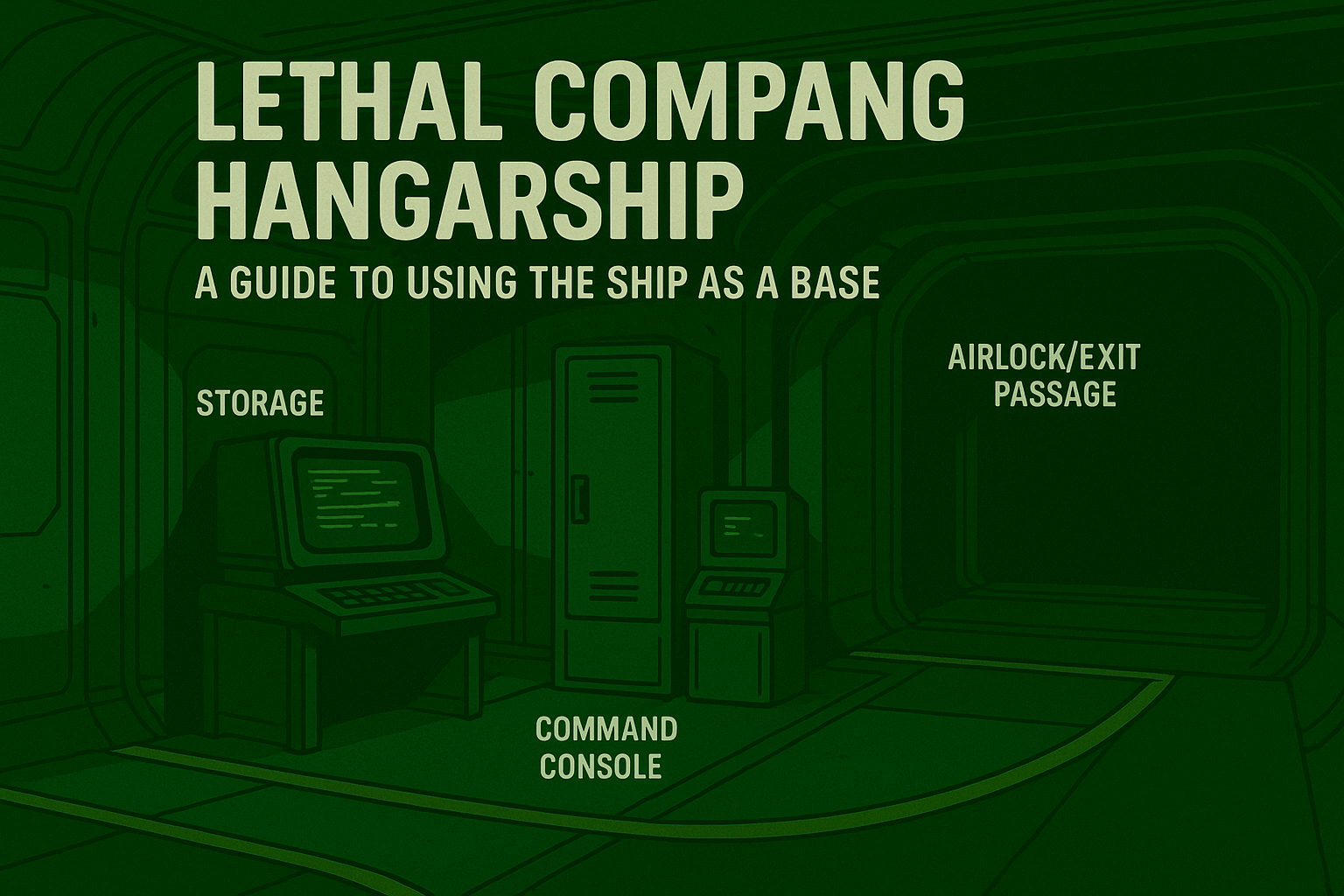Introduction
In the dynamic and increasingly competitive universe of Lethal Company, the hangership serves as a critical operational hub. It is more than just a transport vessel—it is a fully integrated command center for crew planning, equipment organization, crisis response, and strategic execution. Understanding how the hangership functions and how to best utilize its systems can determine whether your expeditions are profitable or catastrophic. This blog post explores the essential structure, configuration, and practical uses of the hangership in Lethal Company, offering actionable insight into both basic functionality and advanced operational strategies.
Understanding Your Operational Hub: A Summary of the Hangership
The hangership in Lethal Company functions as the player’s mobile base of operations. It is where contracts are selected, equipment is managed, and team coordination is established. Its purpose spans several aspects:
- Central location for player coordination
- Entry and exit point for missions
- Data terminal access for strategic decision-making
- Equipment storage and inventory management
- Emergency fallback during failed expeditions
Players return to the hangership after each planetary run, and its importance grows over time. Whether coordinating with AI or human teammates, this space functions as the brain of all operations.
Essential Configuration and Key Attributes
The hangership’s configuration includes multiple interactive zones that are vital for planning and executing operations. The layout is intentionally minimal, allowing for functionality without excess complexity. Key attributes include:
- Command Console – Where mission routes are plotted
- Storage Containers – Used for storing retrieved scrap and gear
- Suit Station – For equipping special suits or mobility gear
- Terminal Access – For typing commands, managing ship operations, or connecting to the in-game economy
- Monitor Viewpoints – For observing exterior environments or monitoring team progress
Each of these elements has a practical use, making it essential for players to familiarize themselves with their placement and functionality early in the game.
Control Center: The Heart of Functionality
At the core of the hangership is the control center terminal, which plays a pivotal role in day-to-day gameplay. This terminal provides:
- Mission Navigation: Typing commands into the terminal selects the next destination, adjusts ship settings, and syncs systems.
- Data Input: Players type real-time instructions for docking, landing, or returning to orbit.
- Financial Monitoring: Display of contracts, quotas, and scrap value for proper profit estimation.
- Team Synchronization: The terminal communicates with team systems, ensuring all players are aligned on objectives.
Proficiency with the terminal can make or break a mission. Knowing the right command at the right time ensures minimal delays and optimized performance.
Improved Storage and Equipment Management
The hangership contains a limited yet expandable storage system. Effective use of this area plays a key role in:
- Organizing scrap retrieved from planetary surfaces
- Safely storing high-value artifacts
- Securing tools, sensors, and survival equipment
- Preventing equipment loss during panic or emergency exits
Storage lockers and magnetic trays can be used to categorize gear by mission type. Players may assign lockers for medical supplies, mechanical tools, or energy-based devices. This organization streamlines mission preparation and reduces confusion when time-sensitive operations are underway.
Additionally, managing weight and item placement can affect how quickly equipment can be accessed after re-entry, making efficiency more than just a convenience—it’s a survival tool.
Ship Personalization and Upgrades
While the base model of the hangership comes with standardized modules, gradual upgrades and personalization options are available. These include:
- Interior Aesthetic Changes: While mostly cosmetic, they allow teams to mark specific stations or zones for improved coordination.
- Lighting Systems: Can be adjusted for clearer visibility or stealthier entry.
- Enhanced Storage Units: Upgraded lockers with more slots or magnetic hold.
- Command Terminal Mods: Features that offer shortcuts, pre-saved commands, or economic analytics.
- Emergency Hardware: Including reinforced doors or radiation shielding for missions in hazardous environments.
Upgrades require in-game currency or completed mission contracts. Choosing the right enhancements can drastically improve mission survivability and resource collection efficiency.
Safety Regulations and Crisis Procedures
Despite its strategic benefits, the hangership is not impervious to threats. From external assaults to internal system failures, players must adhere to safety regulations and crisis procedures. These include:
- Lockdown Mode: Activating internal security to prevent hostile boarding.
- Emergency Ventilation: Releasing toxic or volatile gas buildup.
- Crew Recall Protocol: Signal that alerts all teammates to return due to impending danger.
- Fire Suppression Systems: Controls for extinguishing equipment-based fires.
A lack of knowledge in crisis response often results in player loss or mission failure. It’s advisable for each team member to undergo mock drills and become familiar with every emergency mechanism on board.
Crew Collaboration and Management
The hangership serves as the central platform for team coordination. Players must manage communication, assign roles, and debrief after missions—all from within this space. Effective collaboration includes:
- Role Assignments: Determining who pilots the ship, monitors health, or handles navigation.
- Inventory Checks: Ensuring tools are distributed properly before each landing.
- Mission Strategy Meetings: Reviewing objectives, terrain maps, and threat levels.
- Post-Mission Debriefs: Analyzing what went right or wrong for future improvement.
Well-functioning teams treat the hangership as a military command center. Structured routines, clear communication, and role consistency improve group cohesion and in-game performance.
Advanced Tactics for Success
Experienced players go beyond basic hangership use. Advanced tactics include:
- Pre-Scripting Terminal Commands: Typing partial commands ahead of time for faster execution in emergencies.
- Using the Hangership as a Decoy: Triggering its systems remotely to distract or mislead threats.
- Backloading Valuable Cargo: Prioritizing high-value items in the storage closest to the ship’s exit for quick transfer.
- Security Rotation: Assigning crew members to stand watch at the hatch during risky operations.
These methods take advantage of every inch of the hangership’s infrastructure. They don’t guarantee success, but they improve odds significantly.
Addressing Common Issues
Despite its functionality, players often encounter issues with the hangership. Below are frequently encountered issues along with their respective solutions:
| Issue | Cause | Solution |
|---|---|---|
| Ship Not Responding to Terminal Input | Typing error or system delay | Check syntax; reboot terminal module |
| Storage Items Disappearing | Exceeding weight limits or save glitches | Regular backups and compartmentalizing storage |
| Crew Communication Fails | Audio bugs or configuration errors | Use visual cues and recheck mic settings before mission starts |
| Power Failure | System overload from recent upgrades | Scale back modifications or use manual override |
| Panic Lockout | Players locked out during emergency | Assign one player inside to monitor hatch control |
Knowing how to troubleshoot these issues minimizes downtime and prevents frustration during crucial moments.
Future Prospects
As Lethal Company continues to receive updates, developers are likely to expand the functionality and features of the hangership. Anticipated developments may include:
- Automated Systems: AI modules that assist in diagnostics, terminal input, or navigation.
- Expanded Living Quarters: Areas to rest, regenerate health, or analyze mission data.
- Specialized Hangership Models: Variants tailored for different playstyles—stealth, combat, or exploration.
- External Docking Modules: Allowing for the attachment of research labs, cargo bays, or repair stations.
- Integrated Economic Platforms: Buy and sell gear directly from the hangership via uplink to in-game markets.
These potential enhancements would increase the hangership’s value and introduce deeper strategic layers into gameplay.
Conclusion
The hangership in Lethal Company is not merely a vessel—it is the foundation upon which all missions are built. From command control and equipment logistics to safety systems and team collaboration, its importance cannot be overstated. Success within the game depends heavily on a player’s ability to master this operational hub. By understanding each function, resolving common issues, and applying advanced tactics, players can transform their hangership into a true command center of efficiency and resilience.
Whether you’re a solo operator or part of a coordinated team, the hangership stands as the core infrastructure for every profitable venture in Lethal Company. Learn it. Upgrade it. Master it.
FAQS
1. What is the hangership in Lethal Company?
It’s the central hub for team planning, equipment storage, and mission selection in the game.
2. Can the hangership be upgraded?
Yes, players can install better storage, lighting, and emergency systems using in-game earnings.
3. How do players control the hangership?
Through the terminal console, which handles navigation, missions, and internal systems.
4. Is hangership customization purely cosmetic?
Not entirely—some changes improve functionality and coordination within the team.
5. What happens if the hangership malfunctions mid-mission?
Players must follow in-game crisis procedures or lose progress and gear.




